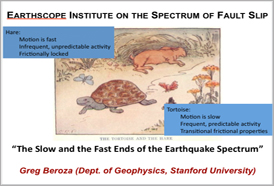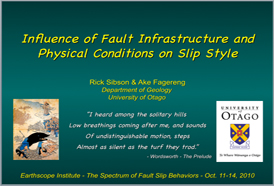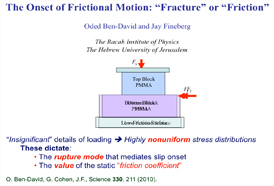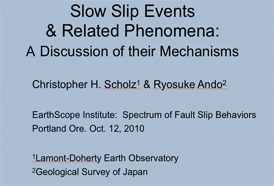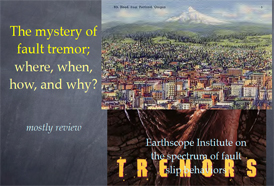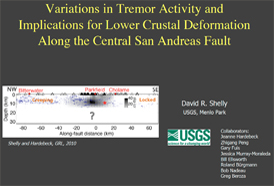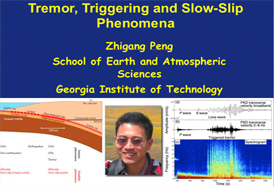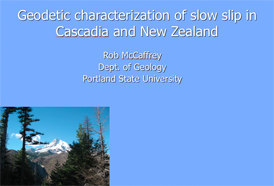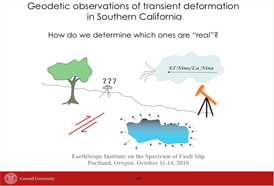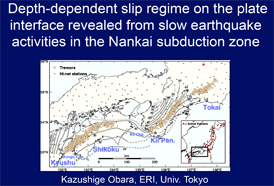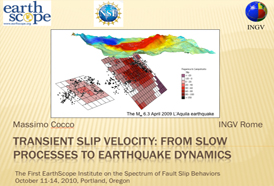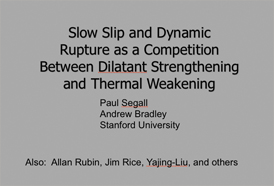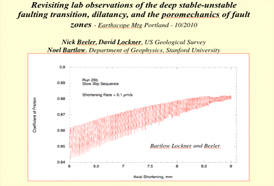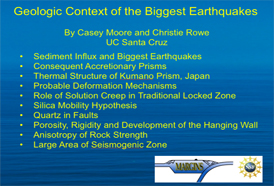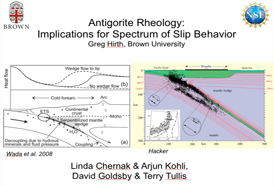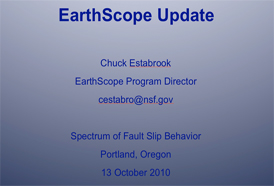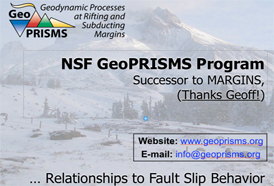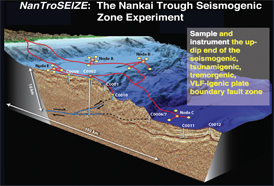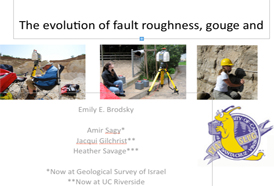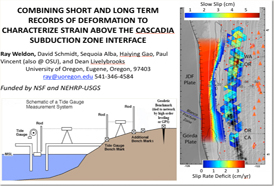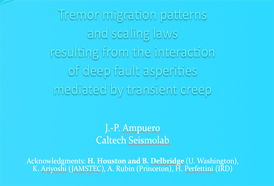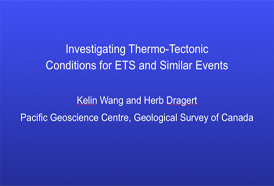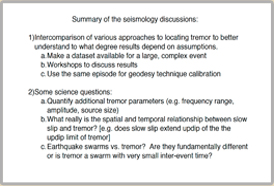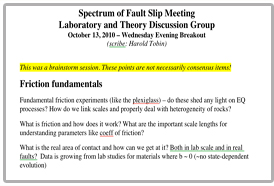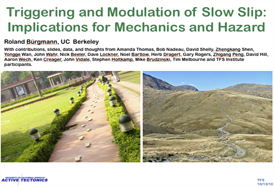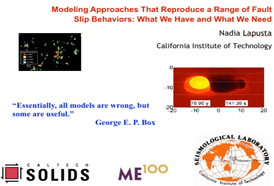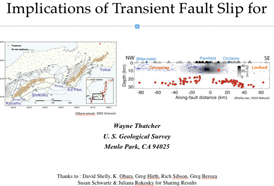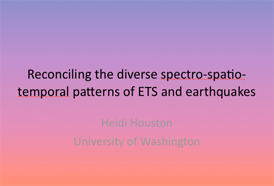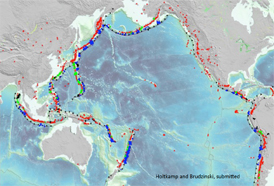The first EarthScope Institute on the Spectrum of Fault Slip Behaviors was held October 11-14, 2010 in Portland, Oregon. The institute aims to 1) foster critical thinking about underlying mechanisms and physical processes responsible for the spectrum of observed fault slip behaviors and 2) promote broad, community-based interest in understanding transient fault slip.
The EarthScope Institute on the Spectrum of Fault Slip Behaviors aims to: 1) foster critical thinking about underlying mechanisms and physical processes responsible for the spectrum of observed fault slip behaviors and 2) promote broad, community-based interest in understanding transient fault slip. A workshop was held to seed collaborations between observational efforts, numerical and theoretical approaches, and laboratory based research. - This is the first in an anticipated series of workshops to spawn virtual EarthScope Institutes intended to engage the scientific community on broad, emerging problems with transformative potential.
Workshop Presentations
Selected presentations and summaries from breakout groups from the October 11-14, 2010 workshop held in Portland, Oregon. Documents are in PDF format and are organized according to the session for which they were presented. Several contributed posters from the workshop are at the bottom of this page.
The Spectrum of Fault Slip I
-
The Slow and the Fast Ends of the Earthquake Spectrum
G. Beroza (Stanford Univ.) -
Influence of Fault Infrastructure and Physical Conditions on Slip Style
R. Sibson (Univ. of Otago, New Zealand)
The Spectrum of Fault Slip II
-
The Onset of Frictional Slip: Fracture, Friction, and Rupture Mode Selection
J. Fineberg (The Hebrew Univ. of Jerusalem, Israel) -
Slow Slip Events & Related Phenomena: A Discussion of Their Mechanism(s)
C. Scholz (Lamont-Doherty Earth Obs.) -
The Mystery of Fault Tremor; Where, When, How, and Why
J. Vidale (Univ. Washington)
Seismic and Geodetic Observations I
-
Variations in Tremor Activity and Implications for Lower Crustal Deformation Along the Central San Andreas Fault, California
D. Shelly (USGS) -
Triggering, Tremor, and Slow-Slip Phenomena
Z. Peng (Georgia Tech) -
Geodetic Characterization of Slow Slip in Cascadia and New Zealand
R. McCaffrey (Portland State Univ.)
Seismic and Geodetic Observations II
-
Geodetic Observations of Transient Deformation in Southern California - How do we Determine Which Ones are "Real"?
R. Lohman (Cornell Univ.) -
Depth-Dependent Slip Regime on the Plate Interface Revealed From Slow Earthquake Activities in the Nankai Subduction Zone
K. Obara (ERI, Univ. Tokyo, Japan)
Theory and Models I
-
Transient Slip Velocity: From Slow Processes to Earthquake Dynamics
M. Cocco (INGV Rome, Italy) -
Slow Slip and Dynamic Rupture as a Competition Between Dilatant Strengthening and Thermal Weakening
P. Segall (Stanford Univ.)
Lab and Geologic Observations I
-
Revisiting Lab Observations of the Deep Stable-Unstable Faulting Transition, Dilatancy, and the Poromechanics of Fault Zones
N. Beeler (USGS) -
Geologic Context of Fault-Slip Behavior in Accretionary Prisms
C. Moore (UC Santa Cruz) -
Deformation of Serpentine: Implications for Interpreting the Spectrum of Fault Slip Behavior
G. Hirth (Brown Univ.)
Emerging Opportunities
Connections to Other Programs-
EarthScope Update
C. Estabrook (NSF) -
NSF GeoPRISMS Program
J. Morgan (Rice Univ.) -
NanTroSEIZE: The Nankai Trough Seismogenic Zone Experiment
H. Tobin (Univ. Wisconsin)
Lab and Geologic Observations II
-
The Fault Zone Cycle
E. Brodsky (UC Santa Cruz) -
Combining Short and Long Term Records of Deformation to Characterize Strain Above the Cascadia Subduction Zone Interface
R. Weldon (Univ. Oregon)
Theory and Models II
-
Tremor Migration Patterns and Scaling Laws Resulting From the Interaction of Fault Asperities Mediated by Transient Creep
J.-P. Ampuero (CalTech) -
Investigating Thermo-Tectonic Conditions for ETS and Similar Events
K. Wang (PGC, Geologic Survey of Canada)
Summary of Disciplinary Discussions
-
The Role of Seismology
-
The Role of Geodesy and Geology
-
The Role of Laboratory and Theoretical Work
The Path Ahead
-
Triggering and Modulation of Slow Slip: Implications for Mechanics and Hazard
R. Burgmann (UC Berkeley) -
Modeling Approaches That Reproduce a Range of Fault Slip Behaviors: What We Have and What We Need
N. Lapusta (CalTech) -
Implications of Transient Fault Slip for Future Work in Tectonic Geodesy
W. Thatcher (USGS) -
Reconciling the Diverse Spectro-Spatio-Temporal Patterns of ETS and Earthquakes
H. Houston (Univ. Washington)
Contributed Posters
- Fournier and Morgan: Earthquake Statistics Using Discrete Element Models [PDF 9.6 MB]
- Gershenzon and Ampuero: Transient Fault Slip in the Framework of Rate-and-State and Frenkel-Kontorova Models [PDF 2.3 MB]


